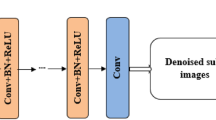Abstract
We present a registration and fusion method of fluorescein fundus angiography image and color fundus image which combines Nonsubsampled Contourlet (NSCT) and adaptive Pulse Coupled Neural Network (PCNN). Firstly, we register two images by Speeded Up Robust Features (SURF) feature points, the nearest neighbor and the next nearest neighbor distance ratio method to eliminate the spatial difference between the source images. Secondly, we use Random Sample Consensus (RANSAC) algorithm to achieve precise matching of feature points. Then, according to the transformation parameters obtained by RANSAC algorithm, we perform spatial transformation on the floating image to complete the registration. Finally, we obtain the low-frequency sub-band and high-frequency sub-band of the image to be fused by NSCT decomposition. The low-frequency sub-band is fused by the regional energy. The high-frequency sub-bands are studied using a simplified-PCNN model and the Particle Swarm Optimization algorithm. The link strength of the simplified-PCNN is an improved Laplacian energy and the images are fused based on the number of times the pixels are ignited. The proposed method has higher average gradient (AG) value and information entropy (IE) value and lower relative global dimensional synthesis error (ERGAS) than the existing fusion methods of the fundus image. The fusion image can accurately synthesize the image information, clarify the performance of the details, and has better spectral quality in the spectral range. The image of fused provides an effective reference for the clinical diagnosis of fundus diseases.







Similar content being viewed by others
References
E. J. Candes (1999) Ridgelets: Theory and application. USA: Department of statistics, Stanford University.
Chen J, Tian J (2010) A Partial Intensity Invariant Feature Descriptor for Multimodal Retinal Image Registration. IEEE Transactions on Biomedi -Cal Engineering 57(7):1707–1718
Cunha AL, Zhou J, Do MN (2006) The nonsubsampled contourlet transform: theory, design, and application. IEEE Trans. Image Proc 15(10):3089–3101
Dai W, Jiang X (2016) NSCT Medical Image Adaptive Fusion Based on Human Visual Properties. J Electron 08(8):1932–1939
Do MN, Vetterli M (2005) The Contourlet Transform: An Efficient Directional Multiresolution Image Representation. IEEE Trans Image Process 14(12):2091–2095
Fischler M, Bolles R (1981) Random sample consensus: a paradigm for model fitting with applications to image analysis and automated cartography. Communication of the ACM 24(2):381–395
Goshtasby AA, Nikolov S (2007) Image fusion: advances in the state of the art. Information Fusion (S1566-2535) 8(2):114–118
Guo F, Zhao X, Zou B, Liang Y (2017) Automatic retinal image registration using blood vessel segmentation and SIFT feature. Int J Pattern Recognit Artif Intell
He F, Guo Y, Gao C (2017) Improved PCNN Method for Human Target Infrared Image Segmentation Under Complex Environments. Acta Opt Sin 2017(2):175–184
Izhikevich EM (1999) Class 1 neural excitability, conventional synapses, weakly connected networks, and mathematical foundations of pulse-coupled. IEEE Trans Neural Netw 10(3):499–507
Ju J, Loew M, Ku B, Ko H (2016) Erratum: Hybrid Retinal Image Registration Using Mutual Information and Salient Features. IEICE Trans Inf Syst E99.D(6):1729–1732
Kennedy J (2001) Swarm Intelligence. Swarm Intelligence 2(1), pp 475–495
Kennedy J (2011) Particle swarm optimization. Springer US: Encyclopedia of Machine Learning 2010:760–766
Li X, Ren J, L Z (2013) Multispectral and Panchromatic Image Fusion Methods Based on Improved PCNN and Regional Energy in NSCT Domain. Infrared and Laser Engineering 42(11):3096-3102
Liao Y, Huang W, Shang L, Li P (2014) Image fusion based on Shearlet and improved PCNN. Computer Engineering and Applications 50(2):142–146
Luo T, Liu B (2015) Fast SURF registration algorithm for fusion features. Journal of Image and Graphics 20(01):95–103
Maia GA, Jose LS, Raquel GC, Rafael G (2004) Fusion of Multispectral and Panchromatic Image Using Improve HIS and PCA Mergers Based on Wavelet Decomposition. IEEE Trans Geosci Remote Sens 2004:1291–1299
Miri MS, Abràmoff MD, Kwon YH, Garvin MK (2016) Multimodal registration of SD-OCT volumes and fundus photographs using histograms of oriented gradients. Biomedical Optics Express 7(12):5252–5267
Nencini F, Garzelli A, Baronti S, Alparone L (2007) Remote sensing image fusion using the curvelet transform. Information Fusion (S1566-2535) 8(2):143–156
Santosh KC, Alam N, Roy PP, Wendling L, Antani S, Thoma GR (2016) A Simple and Efficient Arrowhead Detection Technique in Biomedical Images. IJPRAI 30(5):1–16
Santosh KC, Roy PP (2018) Arrow detection in biomedical images using sequential classifier. Int J Mach Learn Cybern 9(6):993–1006
Song J, Gan J, Liu S (2016) Infrared and visible image fusion based on PCNN and region characters. Computer Engineering and Applications 52(8):186–190
Song R, Wang M, Wang X (2016) Multifocus Image Fusion Algorithm Based on NSCT and Edge Detection. Journal of Computer - Aided Design and Graphics 28(12):2134–2141
Sun Y, Jiang L (2017) Color multi-focus image fusion algorithm based on fuzzy theory and dual-tree complex wavelet transform. Journal of Algorithms & Computational Technology 11(2):164–169
Wu J, Song S, Zhang D, Yang S (2017) Research on fundus image registration and fusion method based on NSCT and adaptive PCNN. International Journal of Engineering Inventions
Yang L, Liu Y, Liu X (2009) Medical Image Fusion Based on Wavelet Packet Transform. Chin J Biomed Eng 28(1):12–16
Zhou D, Gao C, Guo Y (2014) A coarse-to fine strategy for iterative segmentation using simplified pulse-coupled neural network. Soft Comput 18(3):557–570
Acknowledgements
This work was supported by the National Natural Science Foundation of China, under grant No. 61771340; Tianjin Science and Technology Major Projects and Engineering, under grant No. 17ZXHLSY00040, No. 17ZXSCSY00060 and No. 17ZXSCSY00090.
Author information
Authors and Affiliations
Corresponding author
Additional information
Publisher’s note
Springer Nature remains neutral with regard to jurisdictional claims in published maps and institutional affiliations.
Preliminary results of this work were presented at the 3rd International Symposium on Artificial Intelligence and Robotics (ISAIR) 2018, Nanjing, China.
Rights and permissions
About this article
Cite this article
Wu, J., Ren, X., Xiao, Z. et al. Research on fundus image registration and fusion method based on nonsubsampled contourlet and adaptive pulse coupled neural network. Multimed Tools Appl 79, 34795–34812 (2020). https://doi.org/10.1007/s11042-019-08194-9
Received:
Revised:
Accepted:
Published:
Issue Date:
DOI: https://doi.org/10.1007/s11042-019-08194-9




